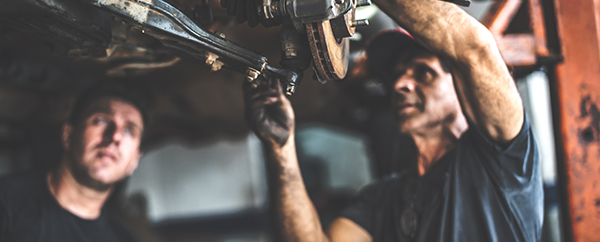Share these tips on automotive shop safety orientation with your Aftermarket clients
Your Automotive Aftermarket insurance client knows how critical safety is to their employees, their customers – and their insurance premiums. As their agent, you can help them create an automotive shop safety orientation for new employees.
Why is this so critical? While the shop owner knows safety is crucial, he may deploy trial-and-error learning and hit-and-miss instruction, rather than a systematic instruction plan. After all, says Zurich, planning is at the foundation of new employee orientation – particularly when it comes to automotive shop safety orientation.
Find new techs more easily with our Automotive Aftermarket added service: S/P2®
Automotive work takes place around potentially dangerous machinery, tools and chemicals, creating any number of dangers to mechanics. While the service areas may never be completely free of hazards, shop owners can significantly reduce the risk of injury by providing regular training and requiring that technicians follow basic safety procedures on the job.
It’s up to repair shop owners and their staff to ensure proper safety precautions and rules are implemented and followed at all times. Safety measures help protect employees from accidental injuries to themselves, their co-workers and the vehicles they’re repairing.
Related: Aftermarket loss prevention best practices
Encourage your clients to start with a careful check of the requirements of specific jobs and compare them with expected job performance. Define each job function in terms of duties and responsibilities, quality of work expected and mistakes and errors to be avoided.
The goal of effective training is to reduce and eliminate unsafe acts. Start training the day a new employee begins work.
Automotive shop safety orientation for new employees
A successful automotive shop safety orientation process has two basic phases: general orientation and job-specific orientation. Both should be completed before the new employee actually begins working.
General orientation
Objectives of this training include a firm understanding of the company’s loss prevention philosophy, compliance with company rules and general familiarity with your business.
In this section, include such topics as what to do in case of an emergency: an explosion, fire, earthquake, flood or blizzard. All employees – new or otherwise – should be regularly trained on emergency equipment such as fire extinguishers and first aid kits. Different types of fires require different ways to combat them – make sure employees know the difference.
Related: Top reasons to add Auto Aftermarket Express Package to your producer portfolio
Safety policies: the basics
Techs should be trained to observe OSHA standards such as keeping exits clear and ensuring that their work areas are always properly ventilated. Additionally,
- Do not smoke in or around the repair bays or garages.
- Keep safety equipment like fire extinguishers accessible and well-maintained.
- Use “wet floor” signs after cleaning or spills.
- Know the location of the electrical shut-off, as well as how to operate it.
- Repair or discontinue the use of any electrical equipment with frayed cords to prevent electrocution and electrical fire.
- When a tool or piece of equipment needs repair, train techs to tag it with a sign or sticker so others don’t use it by accident.
- Carefully read the labels on any chemicals before use.
Job orientation
Managers should train employees on safe operating practices in doing their assigned job, explain all hazards of the job and provide proper protective equipment to avoid personal injury or illness. Safety topics should include:
- Keep work spaces clean and organized. Put away tools when they are not in use.
- When working on a vehicle, remove the keys from the ignition switch.
- Disconnect the car’s battery when working on an electrical system or with wiring. A car with a key in the ignition switch can still draw current from the battery.
- Avoid unplugging fuses or working on wiring until you’ve made sure that no current can pass through the system and shock you or cause electrical damage to the vehicle.
- Check the temperature of the car before working on the engine, manifold, exhaust system or the radiator. All can cause burns when they are hot. Don’t open the radiator until the car is completely cooled down.
- Double-check that the vehicle you’re working on is fully supported before working underneath it.
- Keep your hands, tools and other objects away from the engine while it is running so that nothing gets caught on any moving part.
As an aid to ensure that all appropriate information has been presented, an employee orientation checklist should be used and signed by the employee. This checklist should be maintained in the individual personnel files. Adding incentive programs for maintaining an accident-free workplace or rewarding employees who model your safety program are inexpensive ways to emphasize your shop’s commitment to safety.
An effective automotive shop safety orientation effort increases worker skill, satisfaction, and motivation. The results are increased productivity, reduced absenteeism, fewer on-the-job injuries and less employee turnover. A successful employee training program is a critical component of a shop’s loss prevention program.
Agents, take a look at our Automotive Aftermarket Program to add to your portfolio of insurance solutions.
Resources:
Zurich’s Risk Management and Safety considerations for automotive aftermarket businesses
Safety rules for automotive repair shops
Workplace Safety for Automotive Repair
Does your auto repair shop have a safety manual?

